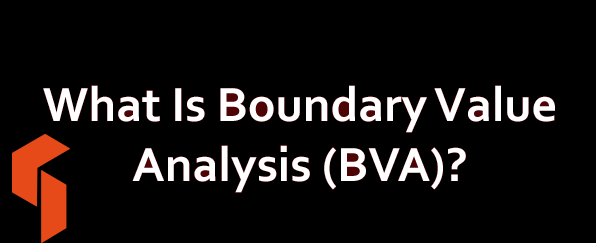Boundary value analysis (BVA) is based on testing at the boundaries between partitions. Here we have both valid boundaries (in the valid partitions) and invalid boundaries (in the invalid partitions).
- As an example, consider a printer that has an input option of the number of copies to be made, from 1 to 99. To apply boundary value analysis, we will take the minimum and maximum (boundary) values from the valid partition (1 and 99 in this case) together with the first or last value respectively in each of the invalid partitions adjacent to the valid partition (0 and 100 in this case). In this example we would have three equivalence partitioning tests (one from each of the three partitions) and four boundary value tests. Consider the bank system described in the previous section in equivalence partitioning.
 Because the boundary values are defined as those values on the edge of a partition, we have identified the following boundary values: -$0.01 (an invalid boundary value because it is at the edge of an invalid partition), $0.00, $100.00, $100.01, $999.99 and $1000.00, all valid boundary values. So by applying boundary value analysis we will have six tests for boundary values.
Because the boundary values are defined as those values on the edge of a partition, we have identified the following boundary values: -$0.01 (an invalid boundary value because it is at the edge of an invalid partition), $0.00, $100.00, $100.01, $999.99 and $1000.00, all valid boundary values. So by applying boundary value analysis we will have six tests for boundary values.
Compare what our naive tester Robbin had done: he did actually hit one of the boundary values ($100) though it was more by accident than design. So in addition to testing only half of the partitions, Robbin has only tested one sixth of the boundaries (so he will be less effective at finding any boundary defects).
If we consider all of our tests for both equivalence partitioning and boundary value analysis, the techniques give us a total of nine tests, compared to the 16 that Robbie had, so we are still considerably more efficient as well as being over three times more effective (testing four partitions and six boundaries, so 10 conditions in total compared to three).
By showing the values in the table, we can see that no maximum has been specified for the 7% interest rate. We would now want to know what the maximum value is for an account balance, so that we can test that boundary. This is called an ‘open boundary’, because one of the sides of the partition is left open, i.e. not defined. But that doesn’t mean we can ignore it, we should still try to test it, but the question is how?
Open boundaries are very difficult to test, but there are different ways to approach them. Actually the best solution to the problem is to find out what the boundary should be specified as! One approach is to go back to the specification to see if a maximum has been stated somewhere else for a balance amount. If so, then we know what our boundary value is. Another approach might be to investigate other related areas of the system.
For example, the field that holds the account balance figure may be only six figures plus two decimal figures. This would give a maximum account balance of $999 999.99 so we could use that as our maximum boundary value. If we still not able to find anything about what this boundary should be, then we probably need to use an intuitive or experience-based approach to check it by entering various large values trying to make it fail.
We can consider another example of Boundary value analysis where we can apply it to the whole of a string of characters (e.g. a name or address). The number of characters in the string is a partition, e.g. between 1 and 30 characters is the valid partition with valid boundaries of 1 and 30. The invalid boundaries would be 0 characters (null, just hit the Return key) and 31 characters. Both of these should produce an error message.
Other popular articles:
- While testing why it is important to do both equivalence partitioning and boundary value analysis?
- What is Equivalence partitioning in Software testing?
- Where to apply this test coverage in software testing?
- What are the types of coverage?
- What is Acceptance Test-Driven Development in Agile Methodology?
jaswinder says
very good website for everyone who is really new to the testing career.
jaswinder says
its a great page, who are very new to testing career.
Venkatesh Chintakindi says
better than other web pages …This is very useful for employees and students who are not aware of such information about SWE.
Myntra Reddy says
better than many other web pages …This is very useful for students who are not aware of such information about SWE.
Trilochan Badal says
Great work and thanks a lot for providing such information.
It was really helpful for my examination.
Chandana Mishra says
Very helpful website. As i am learning testing its helping me a lot to understand the course.